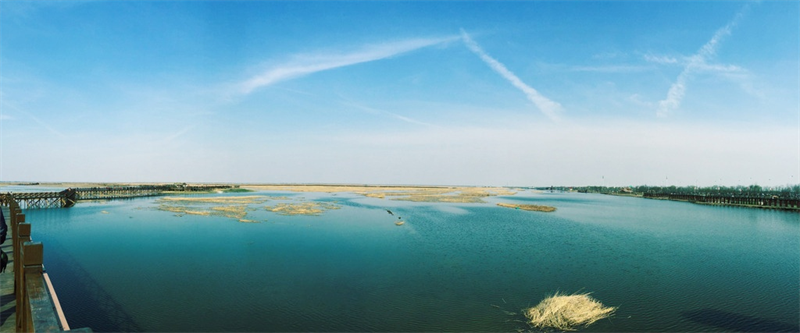
Ninghe district, Tianjin city, located at the core of the Circum-Bohai Sea Economic Zone, is a crucial node of the Bohai Economic Rim and the Capital Economic Circle. Covering an area of 1,296 square kilometers, it has jurisdiction over 13 towns, two sub-districts, 270 administrative villages, and 35 neighborhood committees, with the urban area located in the sub-district of Lutai. In 2020, Ninghe district's regional GDP was 31.278 billion yuan ($4.94 billion), an increase of 8.3 percent; its public budget revenue was 2.383 billion yuan; the district's fixed asset investment reached 15.903 billion yuan, up by nine percent; and its per capita disposable income was 29,608 yuan, a growth of 3.6 percent.
Economic development
Ninghe district has increased efforts to develop Tianjin Future Science and Technology City, construct facilities of the Beijing-Tianjin cooperation demonstration zone, and advance the Tianjin-Hebei coordinated development demonstration zone. A number of high-end, high-quality and high-tech projects started construction, including the new campus of Civil Aviation University of China, the Aviation Innovation and Entrepreneurship Industrial Park, and Fengrun Pharmaceuticals. In 2020, it attracted investment from as many as 63 enterprises in Beijing, with targeted investment of 8.67 billion yuan.
Ninghe district gives full play to the leading role of the North China base of FAW-Volkswagen Automotive Co., Ltd., the annual production capacity of which reaches 300,000, and has gathered more than 40 upstream and downstream enterprises. Its production capacity of special steel and high-grade packaging paper ranks in the forefront of Tianjin Municipality, and installed capacity of wind power is 692 MW. In 2020, the total industrial output value of the district increased by 6.9 percent year-on-year, ranking second in Tianjin.
Ninghe district is accelerating development of the modern service industry and now has 71 e-commerce and related enterprises. With booming e-commerce industrial parks, urban complex projects, vegetable markets, fresh food supermarkets, and convenience stores, a new urban business circle is being formed in the district. In addition, Ninghe has developed municipal-level characteristic towns and cultural tourism villages and holds a variety of cultural tourism activities such as the river crab festival and the intangible cultural heritage shopping festival, with all-for-one tourism becoming a new highlight of economic growth.
Ninghe district is improving its business environment, attracting more than 10,000 new market entities and 2,436 new enterprises in 2021, as well as 1,771 people who settled down with permanent residence registration through the Haihe Talents Project. The district has put more efforts in the reform of streamlining administration, delegating powers, improving regulation, and strengthening services, and built a platform for handling government affairs. The ratio of "online handling" and "handling at one time" exceeds 85 percent, and the business of opening an enterprise can be completed on the same day as the application. The district also opened a public credit center and promoted the use of the App Xinyi+ in a few industries, with a regional integrity level among the top in Tianjin.
Committed to opening up, the heads of Ninghe district visited a number of cities across the country for business development and negotiation in 2021, attracting 44.6 billion yuan of investment throughout the year. The district also upholds the Belt and Road initiative and supports enterprises to participate in international competition and cooperation, with its foreign trade exports exceeding 2.1 billion yuan.
Ecological Protection and Restoration of Qilihai Wetland
The Qilihai Wetland Reserve, covering an area of 359.13 square kilometers and accounting for 12 percent of the total wetland area in Tianjin, is located in Ninghe district. An important part of the ecological layout of Tianjin, it is known as the "green lung of Beijing and Tianjin". In 2020, Ninghe district started the ten protection and restoration projects of the Qilihai Wetland. By the end of the year, six projects including the clearance of historical problems and land transfer were completed, and four projects of water diversion and storage and construction of artificial wetlands in the experimental area were underway.
To increase the wetland area, Ninghe district relocated 856 tombs, blocked 34 roads to the wetland's core area, and constructed 49-kilometer-long fences along the wetland. It also increased resettlement of local residents for ecological purposes. The resettlement housing projects in Panzhuang Town and Beihuaidian Town were capped, and their supporting facilities sped up construction. In addition, resettlement of 25,000 people in five villages in the buffer zone of the reserve is about to start.
Ninghe district has worked diligently on vegetation restoration, restoring around 1,333.33 hectares of wetland, building 1,000 hectares of shoals, renovating more than 20 bird islands, and discharging two million fish fry and adult fish, which significantly enhanced the ecological structure and functions of the wetland.
Adhering to cross-regional water transfer, storage and replenishment, Ninghe district has built five water replenishment lines and37 kilometers of delivery channels, and excavated and dredged more than 80 kilometers of main, branch, and outer ring canals in the core wetland areas. It has also built three rubber dams. It completed regulation of the Zengkou River and Qinglong Bay, and put the renovated Qilihai South Station into use, providing an annual water supply of 80 million cubic meters.
Through continuous efforts over years, Ninghe district restored 2,333.33 hectares of wetland and increased water areas by 1,000 hectares. The number of wild plant species reached 153, and those of birds rose to 258. The district's comprehensive environmental quality index increased from 126.37 to 127.39, and its experience in wetland protection and restoration was selected as a nationwide model of ecological and environmental protection.





